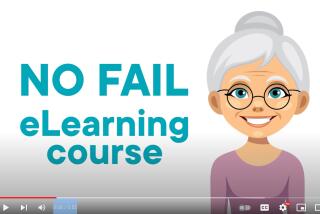Government unveils new citizenship test
- Share via
WASHINGTON — The Bush administration unveiled a revamped citizenship test Thursday intended to promote assimilation and patriotism -- a redesign some critics contend erects a higher hurdle for immigrants who want to become citizens.
The 100 new civics questions -- which test knowledge of American government, history and civics and take effect Oct. 1, 2008 -- will require less rote memorization and are meant to focus more on fostering identification with American values.
For example, applicants may currently be asked, “What country did we fight during the Revolutionary War?” But starting next year, applicants could be asked to explain why the colonists fought the British. They may also have to describe what the “rule of law” is and outline one constitutional amendment concerning the right to vote. (Applicants are asked 10 questions and must answer at least six correctly to pass.)
“This is a naturalization test which genuinely captures the applicant’s knowledge of what it is he’s about ready to be, a United States citizen,” said Emilio T. Gonzalez, director of U.S. Citizenship and Immigration Services. “It’s no longer a test about how many stars are on the flag or how many stripes; it’s a test that genuinely talks about those things that make America what it is.”
But immigrants’ advocates who tried to shape the test’s redesign expressed deep disappointment. Some, citing a recent 69% increase in the citizenship application fee (now $675), said it was another barrier for legal permanent residents hoping to become Americans. They said that whereas the current 96 fact-based questions could be correctly answered in various ways, the abstract new questions required the exact answers in the study materials.
“We’ve always been concerned that people with lower levels of education would have trouble with this new test and people of lower income would not be able to pay for the process,” said Fred Tsao, policy director of the Illinois Coalition for Immigrant and Refugee Rights. “Mexicans, as a group, fall into that category. That’s always been a concern. Of course, the administration will deny it.”
Karen K. Narasaki, director of the Asian American Justice Center, worked with immigration officials on overhauling the test. She said the update was needed but “they seem to have missed the mark. We do think this adds to the barriers to citizenship.”
Narasaki also said she thought the Bush administration might be politicizing the test.
She pointed to Question 67, which she said encapsulated the test’s increased difficulty as well as a new political tinge: “The Federalist Papers supported the passage of the U.S. Constitution. Name one of the writers.”
Conservatives who believe in restricting federal power often cite the Federalist Papers, a series of articles advocating ratification of the Constitution. During the 2006 immigration debate, Sen. James M. Inhofe (R-Okla.) offered an amendment to require that test-takers be asked about the Federalist Papers.
“This seems to be something pushed by conservatives with a conservative agenda,” Narasaki said. “There aren’t a whole lot of other people who think this is relevant to a new immigrant, to help them understand who we are as a country.”
Chris Bentley, a spokesman for U.S. Citizenship and Immigration Services, disputed such charges.
The question is there because the Federalist Papers were “an important event that helped shape the Constitution,” Bentley said.
The questions are just one part of the naturalization process. Applicants are also required to write and read basic English sentences that focus on civics and undergo an interview.
The redesigned questions went through four months of testing at 10 agency offices that were chosen for their diversity and varying caseloads. None were in California.
Applicants were offered the chance to take the new test. The 6,000 people who volunteered were assured that if they failed, they could try the current test.
As with the current test, applicants who fail are given a second chance.
If they fail a second time, they must reapply for citizenship and once again pay the $675 fee.
Alfonso Aguilar, chief of the Office of Citizenship, said 94% of the volunteers passed the new test; 84% pass the current test.
--
--
(BEGIN TEXT OF INFOBOX)
Different approach
The new civics section of the U.S. Citizenship and Immigration Services citizenship test is a combination of streamlined questions from the current test and new ones.
To answer the new questions correctly, applicants must provide one of the agency’s suggested answers. Here are a few examples from the current test and the revamped test:
Bill of Rights
Current test : What is the Bill of Rights?
Answer: The first 10 amendments to the Constitution.
Revamped test: What do we call the first 10 amendments to Constitution?
Answer: The Bill of Rights.
Martin Luther King Jr.
Current test: Who was Martin Luther King Jr.?
Answer: A civil rights leader.
Revamped test: What did Martin Luther King Jr. do?
Answer: Fought for civil rights. Or: Worked for equality for all Americans.
Civil War
Current test: Who was president during the Civil War?
Answer: Abraham Lincoln.
Revamped test: What was one important thing that Abraham Lincoln did?
Answer: Freed the slaves. Or: Saved (or preserved) the Union. Or: Led the United States during the Civil War.
Source: U.S. Citizenship
and Immigration Services
More to Read
Sign up for Essential California
The most important California stories and recommendations in your inbox every morning.
You may occasionally receive promotional content from the Los Angeles Times.










